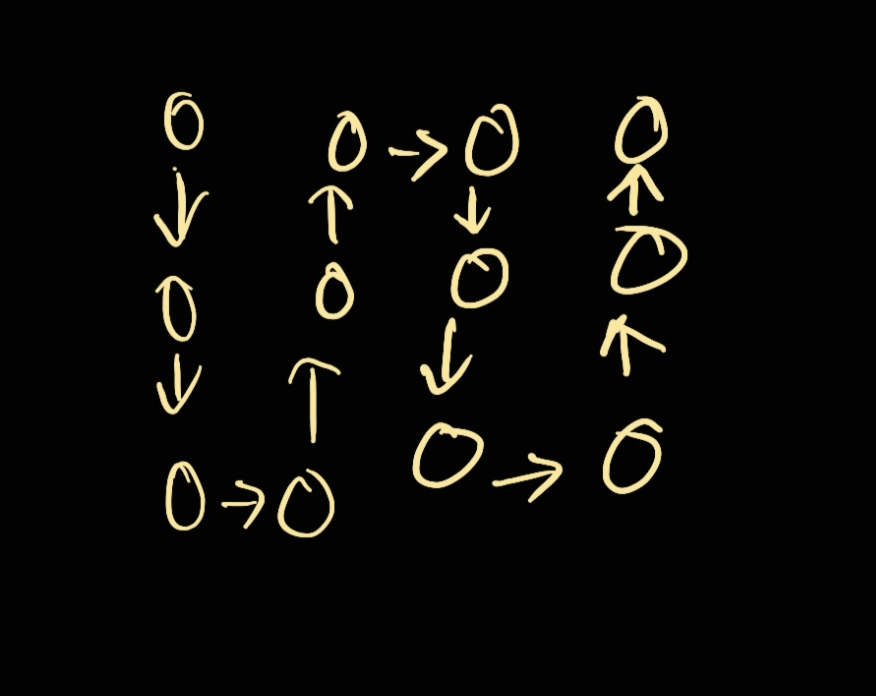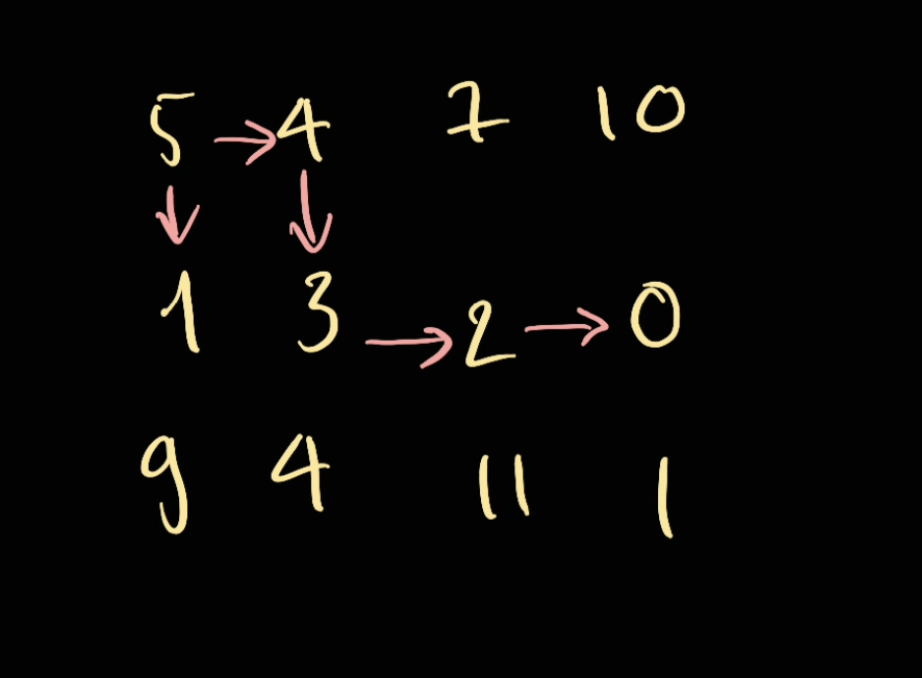Graph Traversal
Given a graph in a format of an 2D array, we want to traverse this graph.
For example
graph = [
[5, 4, 7,10],
[1, 3, 2, 0],
[9, 4,11, 1]
]
DFS traversal
[!note]
For DFS we need to have a visitedsetto keep track of the node that we have already gone through.Without visited
set, it will keep looping in circle
Guard check at DFS
We can do a DFS traversal with the border check in the next loop.
Doing this will has an advantage that even if we call the wrong function at the start (for example we call self.dfs(-1, -1)), the program will exit itself.
class App:
graph: List[List[int]]
def traverse(self, graph: List[List[int]]):
self.graph = graph
self.dfs(0, 0)
pass
def dfs(self, row, col, visited: Set[Tuple[int, int]] = set()):
if row < 0 or col < 0 or row >= len(self.graph) or col >= len(self.graph[0]):
return
if (row, col) in visited: return
visited.add((row, col))
self.visit(row, col)
for (dr, dc) in [(1, 0), (-1, 0), (0, 1), (0, -1)]:
nextRow, nextCol = row + dr, col + dc
self.dfs(nextRow, nextCol)
def visit(self, row, col):
print("Visited: ", row, col)
The traversal will go as follows:

Guard check before DFS
Sometimes if we want we can guard check before we go in the function:
def dfs(self, row, col, visited: Set[Tuple[int, int]] = set()):
if (row, col) in visited: return
visited.add((row, col))
self.visit(row, col)
for (dr, dc) in [(1, 0), (-1, 0), (0, 1), (0, -1)]:
nextRow, nextCol = row + dr, col + dc
if self.isWithinBoundary(nextRow, nextCol):
self.dfs(nextRow, nextCol)
def isWithinBoundary(self, row, col):
return not (row < 0 or col < 0 or row >= len(self.graph) or col >= len(self.graph[0]))
When is it useful
This becomes handy when you when you need some information of the current row before going to the next row.
For example: If we can only go if the nextNumber <= currentNumber, this becomes handy.
Let's revisit our graph:
graph = [
[5, 4, 7,10],
[1, 3, 2, 0],
[9, 4,11, 1]
]
We can then just change our if statement to below:
def dfs(self, row, col, visited: Set[Tuple[int, int]] = set()):
if (row, col) in visited: return
visited.add((row, col))
self.visit(row, col)
for (dr, dc) in [(1, 0), (-1, 0), (0, 1), (0, -1)]:
nextRow, nextCol = row + dr, col + dc
# Change here only
if self.isWithinBoundary(nextRow, nextCol) and self.graph[row][col] >= self.graph[nextRow][nextCol]:
self.dfs(nextRow, nextCol)
This will output visit as follow sequence:
Visited: 0 0
Visited: 1 0
Visited: 0 1
Visited: 1 1
Visited: 1 2
Visited: 1 3

Same scenario but if we do guard check at DFS
We can also do the same thing for Guard check at DFS but however we need to modify our function such that now dfs will take in the previous weight to compare and increase the complexity of the code:
def dfs(self, row, col, previousWeight = float('-inf'), visited: Set[Tuple[int, int]] = set()):
if not self.isWithinBoundary(row, col) or (previousWeight != float('-inf') and self.graph[row][col] > previousWeight): return
if (row, col) in visited: return
visited.add((row, col))
self.visit(row, col)
for (dr, dc) in [(1, 0), (-1, 0), (0, 1), (0, -1)]:
nextRow, nextCol = row + dr, col + dc
self.dfs(nextRow, nextCol, previousWeight = self.graph[row][col])
This will also produce:
Visited: 0 0
Visited: 1 0
Visited: 0 1
Visited: 1 1
Visited: 1 2
Visited: 1 3
However if you look at here, we need to:
- Assign a default
previousWeight = float('-inf')in this case - Update the
previousWeightin the next function to be thecurrentWeight - Compare if:
- The
previousWeightis not default (float(-inf))- The reason why is we need to validate if the
currentWeight <= previousWeightto go. However, this wouldn't work if we set defaultpreviousWeightto-inf. Since there is nothing smaller than-inf. - Doing this will bypass the first iteration to make sure our loop still run
- The reason why is we need to validate if the
- So when it's not
-inf— which means for the next iteration (not the first one), we can then confirm ifcurrentWeight <= previousWeightor not. IfcurrentWeight > previousWeight, we shouldn't perform DFS here.
- The
BFS Traversal
For BFS traversal, we need to use Deque as a queue.
Common mistakes
def bfs(self, row, col):
queue = deque()
visited = set()
queue.append((row, col))
while queue:
row, col = queue.popleft()
visited.add((row, col)) # NOTE HERE
self.visit(row, col)
for (dr, dc) in [(1, 0), (-1, 0), (0, 1), (0, -1)]:
nextRow, nextCol = row + dr, col + dc
if self.isWithinBoundary(nextRow, nextCol) and (nextRow, nextCol) not in visited:
queue.append((nextRow, nextCol))
In here, we should not add to the visited set during the current node. Why? — because we should consider visited when we're adding the node in we should not wait until we actually visiting that node to add that in.
For example in this case, we added a node in visited set before we're adding our candidates to our queue. Therefore the (nextRow, nextCol) not in visited is not valid anymore.
Thus, we need to add in (nextRow, nextCol) not in queue as well to guard this condition — However, this is very expensive since deque is linkedlist, this computation will cost
Since we're visiting whatever we're adding to our queue anyways, we need to make sure we're adding it to visited set when we're adding it in the queue.
What to do
def bfs(self, row, col):
queue = deque()
visited = set()
queue.append((row, col))
visited.add((row, col)) # NOTE HERE
while queue:
row, col = queue.popleft()
self.visit(row, col)
for (dr, dc) in [(1, 0), (-1, 0), (0, 1), (0, -1)]:
nextRow, nextCol = row + dr, col + dc
if self.isWithinBoundary(nextRow, nextCol) and (nextRow, nextCol) not in visited:
visited.add((nextRow, nextCol))
queue.append((nextRow, nextCol)) # NOTE HERE
Note: That we put node in visited as soon as we add them to the queue since we're going to visit them anyways in the next loop.
This will guarantee that we don't visit one node twice and therefore keeping our time complexity is
As a result, this will go as the following:
Visited: 0 0
Visited: 1 0
Visited: 0 1
Visited: 2 0
Visited: 1 1
Visited: 0 2
Visited: 2 1
Visited: 1 2
Visited: 0 3
Visited: 2 2
Visited: 1 3
Visited: 2 3
With graph:
graph = [
[5, 4, 7,10],
[1, 3, 2, 0],
[9, 4,11, 1]
]